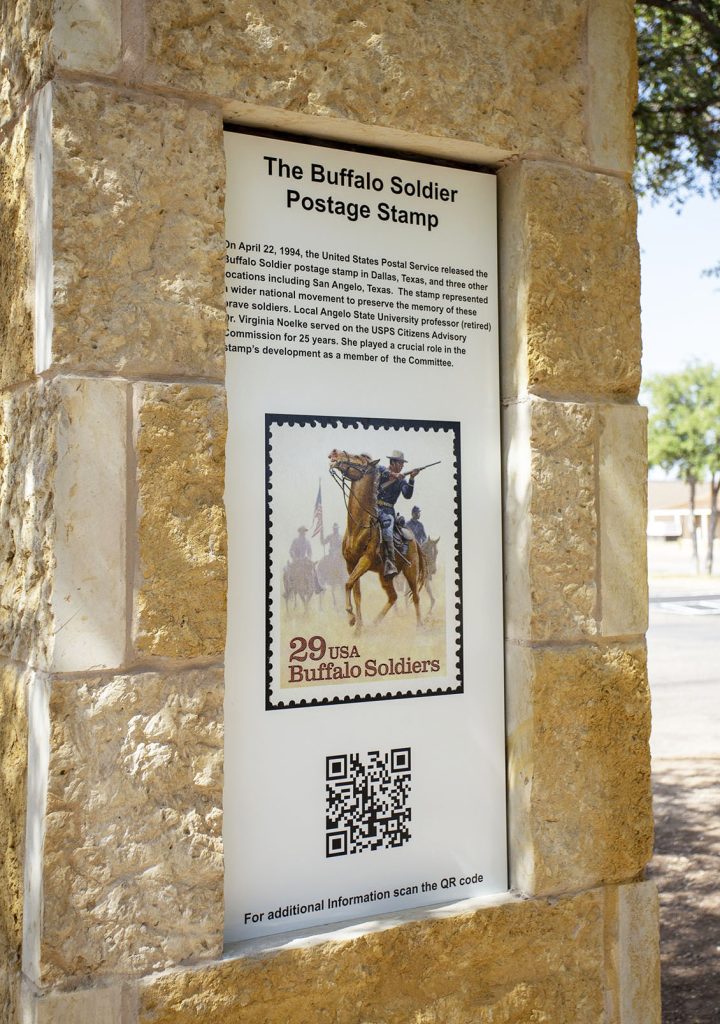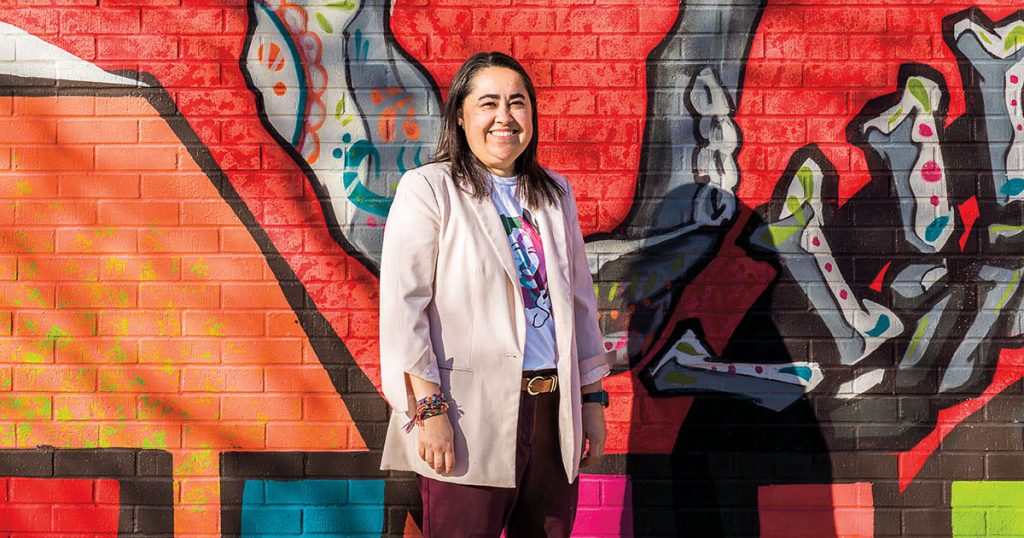
The San Angelo NAACP Buffalo Soldier Memorial is located in El Paseo de Santa Angelo Park in San Angelo. Photo by Becca Sankey Photography.
Named for the strong, burly buffalo that roamed the land, the U.S. Army’s first Black enlisted soldiers left a legacy of perseverance and valor in the swath of territory they served, from Alaska, Hawaii, and the Philippines to almost every state and territory west of the Mississippi River. Between 1868 and 1885, many of the soldiers were stationed in Fort Concho, located in the West Texas town of San Angelo. Nearly 140 years after the Buffalo Soldiers departed Fort Concho, the city has a dedicated place that tells their story.
On July 28, National Buffalo Soldiers Day, 10 8-foot-tall stone monuments that make up the San Angelo NAACP Buffalo Soldier Memorial were unveiled at El Paseo de Santa Angela Park, across the street from Fort Concho National Historic Landmark. Placards on the towering monoliths detail with photos, stories, and QR codes the soldiers’ various roles during the late 19th and mid-20th centuries, including protecting settlers moving West, working as the first park rangers, and serving alongside Theodore Roosevelt’s Rough Riders during the Spanish-American War in Cuba.
“Their most significant contribution from a West Texas, Fort Concho standpoint is they were a critical part of the building and operation of this fort, which was in turn a critical part of the settlement of this part of West Texas,” says Fort Concho director Bob Bluthardt. “Fifty percent of the soldiers who served at Fort Concho were Black at one time, and it’s often forgotten that there were years that all the enlisted soldiers here were Black. They are part and parcel of what Fort Concho was and is.”
Along with providing history about the Buffalo Soldiers, the memorial highlights the achievements of Medal of Honor recipients Sgt. Henry Johnson of Company D, 9th U.S. Cavalry, and Sgt. Thomas Shaw of Company K, 9th Cavalry, who were recognized for their heroic acts during conflicts with Native American tribes. Another monument is dedicated to the postage stamp issued by the U.S. Postal Service in 1994.

Buffalo Soldier postage stamp photo by Becca Sankey Photography
The visionary force behind the memorial’s inception and development is Sherley L. Spears, a San Angelo business owner, community activist, and former president of the San Angelo NAACP. Around 2021, she says she received a “vision from God” for the memorial, which is the only one in Texas that honors all Buffalo Soldier regiments. “The fort has always done something for the Buffalo Soldiers through various programming, but there was not a permanent place outside the fort to honor them,” she says. “I talked to Bob and asked, ‘Is this something you think we can do in [San Angelo]?’ He agreed we could.’”
Bluthardt, who is also a member of Spears’ committee, says Fort Concho has offered educational programs, talks, and events centering on the Buffalo Soldiers for the past half-century, but in more recent years has taken a more “forward-thinking, aggressive approach” regarding their local legacy. “Memorials are hard, they’re expensive, and I think that it is a tribute to Sherley Spears that she took a concept that others had tried and failed and ramrodded it through in 18 months,” he said. “That’s impressive.”
Included in the name of the Buffalo Soldiers memorial is the San Angelo NAACP, chartered in 1946 and for which Spears served as president starting in 2019 until this year. She began fundraising for the memorial in 2021. An anonymous donation for $300,000 made up the bulk of the more than $500,000 raised by individual contributions, including $100,000 from the Bob and Doris Johnston Foundation, and grants from Humanities Texas, the San Angelo Health Foundation, and the San Angelo Area Foundation. Female- or minority-owned local businesses handled the memorial’s landscaping and electrical work, per Spears’ specifications. As for the design, Spears collaborated with KFW Architects to create the memorial’s rendering.
“The committee planning this really got it right in trying to create a place of education and contemplation,” Bluthardt says, adding that each monument has a QR code that provides more information, which the committee will continue supplementing over time.
Along with shade and benches, the memorial’s location is conveniently right off a major roadway, Oakes Street. “And then the Paseo, with parking centrally located in the cultural district, has dozens if not hundreds of events annually, so thousands of people will be wandering through this area” he says. “It couldn’t have been placed in a better spot.”
Finding it very gratifying to see her idea come to fruition, Spears credits others for their assistance. She also is hopeful visitors will appreciate the men whose stories are told through the memorial. “You can’t move forward if you don’t tell your truth,” she says. “And that’s what books and movies and stories [about Black history] and now this memorial are trying to do, to get the truth out there that has not been told.”








